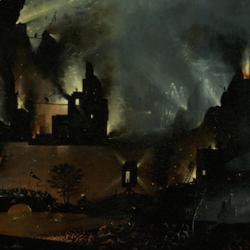Matthew Avery Sutton’s American Apocalypse tells the story of American Evangelicalism by telling the story of premillennial apocalyptic eschatology. The approach throws some fresh light on recent history.
For example, he links premillennialism to the crusading of the Moral Majority: “As humankind approached the last days, the faithful believed that a series of cultural and moral signs would herald the coming apocalypse. Jesus had told his disciples that at the time of his return conditions would parallel those that forced God to destroy the entire world during Noah’s generation and the cities of Sodom and Gomorrah in the days of Lot (Luke 17:26–28). Social, cultural, and sexual debauchery, fundamentalists believed, had provoked God’s judgment on ancient cultures and humans’ unrighteous behavior would call down God’s wrath again. . . . Fundamentalists saw echoes of the world of Noah in popular amusements like the theatre, movies, and dancing and they believed that widespread challenges to traditional gender and racial hierarchies matched the chaotic social order that doomed Sodom and Gomorrah. . . . Completing the revolution that radical evangelicals had begun at the turn of the century, fundamentalists transformed premillennial apocalypticism into a moral crusade on contemporary culture” (116–17).
No doubt there’s something else in the mix here too. After all, it would be perfectly natural for premillennials to see a repeat of Noah’s generation and do nothing but wait for rapture. But Sutton draws out the way premillennial Christians read the signs of the times.
He also makes the case that the much-discussed difference between fundamentalists and evangelicals is overdrawn: “the priorities of pre-war fundamentalists and postwar evangelicals remained far more alike than not. They held remarkably similar views on issues of the state, the economy, women’s roles, African American civil rights, organized labor, and popular culture. The principle change in the postwar era was one of effectiveness, growth in numbers of adherents, and public image. Their ideology and agenda remained consistent” (xiv). And one of the main continuities was in eschatology.











